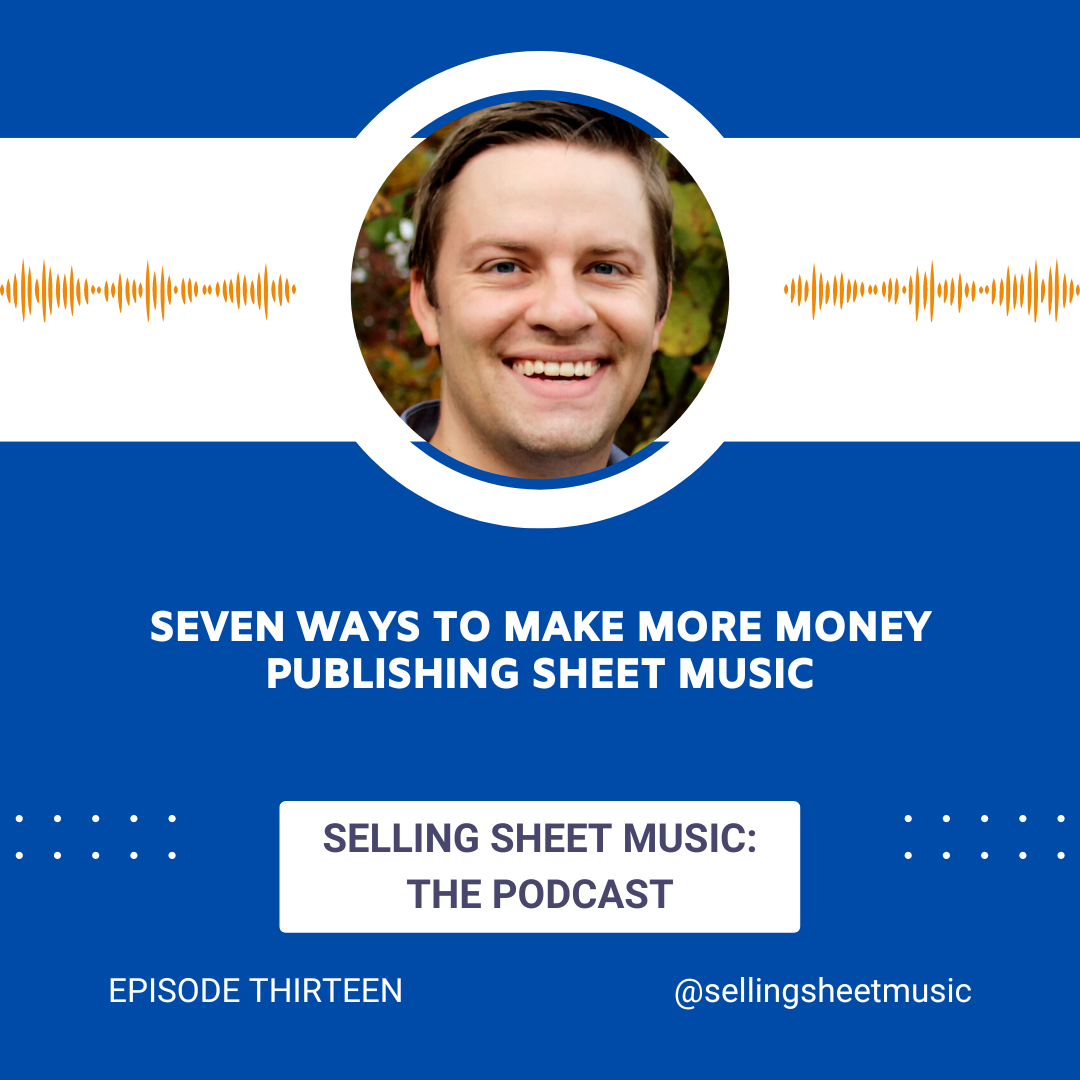Ep. 13: Seven Ways to Make More Money Publishing Sheet Music
Episode Description:
In this episode we’re taking a deep dive into the various revenue streams associated with publishing sheet music. Follow these seven steps to make sure you’re not leaving money on the table!
We’ll talk about the pros and cons of self-publishing, ideas about how to incorporate sheet music sales into what you’re already doing as a musician, and my eight step plan for finding your niche.
Featured On This Episode:

Garrett Breeze
Garrett Breeze is a Nashville-based composer, arranger, publisher, and the founder of Selling Sheet Music. His credits include film, television, video games, Broadway stars, major classical artists, and many of the top school music programs in the U.S. Visit garrettbreeze.com for more information or to book Garrett for a commission or other event.
Episode Transcript:
*Episode transcripts are automatically generated and have NOT been proofread.*
There’s really only three ways for publishers to increase their profits, and I include self-publishers in this as well. They can either a. publish more music, b. market their music more effectively so that they sell more copies, or c. take advantage of secondary revenue streams. We’ve talked about A and B on the podcast before, so today I’m going to focus on that third category.
Your business word of the day is revenue stream, which simply means all of the different ways a product can make money. Think of this episode as your sheet music revenue checklist, and every time you publish a new title, you can refer to the steps in this episode to make sure that you’re making the most out of every product you create. Number one is to distribute your music as widely as possible.
This is something I encounter a lot of resistance to from new and emerging composers. They develop this deep personal connection to their music, and as a result are sometimes unwilling to share royalties or let go of control, deciding to only put it on their personal website. I understand feeling like your music is your baby, and I don’t want to disrespect anyone who approaches it this way.
After all, it’s yours. If you don’t want to share it, that’s your choice. But you are leaving an extremely large amount of money on the table if you decide to do this.
Look at any major publisher, any major composer, and you’ll see their music plastered all over as many distribution sites as possible. Anytime I publish a new composition, it goes on my personal website, JW Pepper through the MyScore program, SheetMusicPlus and SheetMusicDirect through the Arrange.me program, and MusicNotes.com through their Signature Artist program. That right there is five different revenue streams, and what I found is that these website sales don’t really cannibalize each other because they have different audiences.
It’s not like you’re losing sales from one if you put it on the other. But if you’re still hesitant about putting your music out there like this, let me just remind you that publishers don’t make money unless you make money. The composer-publisher relationship, or the composer-distributor relationship, is truly mutually beneficial, and it’s in all parties’ best interest for your music to sell like crazy.
Number two on the list is product variations. Publish as many variations of a piece as you can. For choral, do the different voicings, SATB, SSA, two-part, and so on.
For band music, publish with flexible instrumentation. For piano music, publish different difficulty levels. Rework your quartets to also function as trios and duets.
If you’re selling an instrumental piece, publish the different transpositions so that any instrument can play it. This will dramatically increase the chances of your music getting performed, and it’s especially important to keep in mind because of how digital sales work. Nearly everyone shopping is going to be using search engines, and if they’re searching for a particular voicing or a particular instrument and you don’t have that in the catalog, you’re just not going to show up in the results.
This is also a different way of looking at the quantity versus quality debate. You know, you hear a lot of people talking about how publishing is a numbers game, and the key to success is publishing as many titles as possible. And I think that’s true, but let’s just say for example that I publish a choral piece with five different voicing options, and then I upload that to all five of the websites I mentioned in step one.
All of a sudden that one piece has become 25 products. So you can still play the numbers game even if you have a smaller catalog. Number three is to sell secondary products.
This usually takes the form of the orchestration to a piece that is sold separately, or things like rehearsal tracks, performance tracks, or part learning tracks. But it could also mean a lesson book that goes with the arrangement, or maybe you as an artist have merchandise like t-shirts or stickers or, I don’t know, water bottles. This is an area to be creative, but with each piece it can be worthwhile to think about what else you could sell that ties in.
Number four is to use affiliate links. Affiliate links are basically how all the influencers and youtubers make money. They post a link to a product they endorse, and every time somebody clicks on it and buys something, they get a cut.
Any link you click on in a blog post or a social media ad is probably an affiliate link. It’s really the cornerstone of how people make money online. And if you have a website, you should be using them too.
Sheet Music Plus and Sheet Music Direct have affiliate marketing programs that give you 8 and 10 percent respectively on each sale. If you use affiliate links to share your music on those sites, then that’s adding an extra 8 or 10 percent to your commission. Not only that, but if somebody goes to your website and uses your link to buy one of your titles, and then goes on to buy a bunch of other stuff, you get the affiliate commission on all of the other music they bought because you were the person that brought them to the site.
So you always want to make sure that you’re using affiliate links when you share your titles, and depending on your audience, there may be other ways you can use affiliate links from different companies to make a little extra cash. Number five is a simple one, but one we’re afraid to talk about because we’re musicians and we’re scared of money. But if you have a piece that’s proven successful, you should be charging more for it.
Don’t go crazy of course, but if you have a piece with a proven track record, chances are that it will continue to sell well even if you charge an extra 10, 15, 25, maybe even 50 cents for it. Over time that money will add up. You can also look at pieces that are not selling particularly well and lower the prices to see if that will push people off of the fence.
I will probably do a whole episode just on pricing eventually, but right now the point I want to make is that composers often undervalue their music, and if you have a piece with a proven track record, then don’t literally sell yourself short on it. Number six is another one that will get its own episode at some point, and that is public performance royalties. This is money that is due to you as the composer and publisher when your original compositions are performed publicly.
The manner and rate at which this happens is a little all over the place, and it varies from country to country, but the basic takeaway is that you should be registered as a composer with a performing rights organization. In the US, that’s ASCAP or BMI, and you do have to pick one, and you should register each of your pieces with them so that if a qualifying performance takes place, you get paid. You should also register a publishing company with them to get the publishing side of the money.
I should be clear that this does not apply to arrangements of copyrighted material. If a performance of one of your arrangements takes place, it is the copyright holder of the song, not you, that gets the performance royalty. For certain ensemble types, this can be a significant amount of money, so if you’re not sure, talk to other people in your field and see what they do.
Number seven, last but not least, is sync licensing. If you’ve written an original composition or a song, and you make a recording of it, it may be possible for you to monetize that recording, either by uploading it to a stock music library, such as Pond5 or AudioJungle, or by placing it with a production music library. I think the most famous example of this probably is Pink Zebra, who is an extremely popular composer in the choral world who self-publishes their sheet music on JW Pepper, but also sells the audio recordings of their music on AudioJungle.
The underlying principle to keep in mind is that you control the rights to audio recordings of your music, and anytime those audio recordings are getting used anywhere, you should be getting paid. Again, this is something that’s going to depend a lot on the kind of music you’re writing, but I can think of a number of examples, you know, piano players write music that might work in a wedding video, or maybe a band publishes sheet music of their songs, and then one of their songs gets used on a TV show or something like that. And that’s it for today.
I hope that this episode has turned on a light bulb and shown you some ways you can take advantage of additional revenue streams. And the great thing about it is they all help each other. Having more products makes it easier to find your music.
Having recordings being licensed promote the sale of the sheet music, and vice versa, and so on. So as you do all of this stuff for an individual composition, hopefully it lifts your entire catalog with it.
